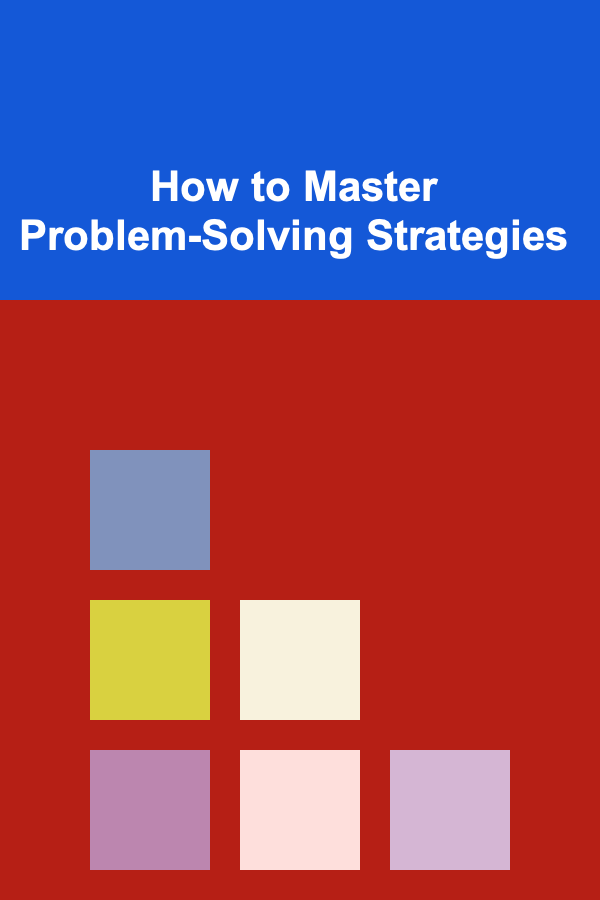
How to Master Problem-Solving Strategies
ebook include PDF & Audio bundle (Micro Guide)
$12.99$11.99
Limited Time Offer! Order within the next:

Problem-solving is an essential skill in both personal and professional life. Whether you're tackling a challenging task at work, navigating personal decisions, or addressing complex issues in a team environment, being able to approach problems strategically is key to success. This article explores how to master problem-solving strategies, breaking down the thought processes, techniques, and mindsets necessary to become an expert problem-solver.
The Importance of Problem-Solving
Problem-solving is not just about finding solutions; it's about understanding the problem in its entirety. In today's fast-paced and ever-changing world, the ability to solve problems quickly and effectively is highly valued. Mastering problem-solving not only allows you to improve your decision-making skills but also enhances your creativity, boosts confidence, and strengthens critical thinking abilities. As you work to master problem-solving, it's important to understand that this is a skill that can be cultivated over time with practice and dedication.
Types of Problems
To effectively tackle problems, it's crucial to first understand the nature of the problem you're facing. Problems can generally be classified into different categories:
1. Well-Defined Problems
These are problems that have a clear goal and a specific solution. Examples include mathematical equations, technical issues, and puzzles. Well-defined problems are typically structured, and the solution can often be found through a methodical, step-by-step approach.
2. Ill-Defined Problems
Unlike well-defined problems, ill-defined problems are vague, complex, and may not have an immediately apparent solution. These problems require critical thinking and creativity to explore potential solutions. Examples include strategic business decisions, ethical dilemmas, or resolving interpersonal conflicts.
3. Complex Problems
These are problems that involve many interrelated components, making the issue difficult to unravel. Complex problems often require a holistic view and can be both well-defined or ill-defined. Examples include climate change, global health crises, and organizational restructuring.
4. Simple Problems
Simple problems are straightforward, often solvable with basic knowledge or routine tasks. These are common in day-to-day life, such as fixing a leaky faucet or deciding what to have for dinner.
Understanding the type of problem you're facing is crucial because it informs the approach you take in solving it.
Problem-Solving Frameworks
Mastering problem-solving involves following a structured approach. There are several frameworks you can apply to organize your thinking and guide you toward the best solution.
1. The IDEAL Framework
The IDEAL framework is one of the most well-known problem-solving methods and is useful for both simple and complex issues. It stands for:
- I: Identify the problem
- D: Define the problem
- E: Explore possible strategies
- A: Act on the chosen solution
- L: Look back and evaluate
This framework encourages you to take a step-by-step approach to problem-solving, ensuring that you fully understand the issue before jumping to conclusions.
2. The Scientific Method
Often used in research and experiments, the scientific method is a logical and systematic approach to solving problems. It involves the following steps:
- Ask a question
- Do background research
- Construct a hypothesis
- Test the hypothesis through experimentation
- Analyze the data
- Draw conclusions and report results
This method is particularly effective for solving well-defined problems, especially when empirical evidence is necessary.
3. The 5 Whys
The 5 Whys technique is a simple yet effective method for solving problems by asking "why" five times. Each answer forms the basis of the next question. This process helps to identify the root cause of an issue. It's often used in root cause analysis in business and manufacturing.
4. The PDCA Cycle (Plan-Do-Check-Act)
The PDCA cycle is a continuous improvement framework that is useful for addressing complex problems. It involves:
- Plan: Identify and analyze the problem, and develop a solution plan.
- Do: Implement the solution on a small scale.
- Check: Evaluate the results of the solution.
- Act: Make the necessary adjustments and implement the solution more broadly.
This cyclical process allows for ongoing refinement of solutions and is effective for solving both well-defined and ill-defined problems.
Essential Problem-Solving Skills
Effective problem-solving requires the development of a variety of cognitive and practical skills. Here are some of the key skills that can help you become a master problem-solver:
1. Critical Thinking
Critical thinking is the ability to analyze, evaluate, and synthesize information in a rational and objective way. This skill allows you to assess the situation, understand different perspectives, and make informed decisions. Developing strong critical thinking skills can significantly improve your ability to solve complex problems.
2. Creativity
Problem-solving is not just about following predefined methods; it often requires innovative thinking. Creativity involves thinking outside the box, considering alternative solutions, and being open to new ideas. Creative problem-solving can lead to breakthroughs and innovative solutions that may not have been obvious at first glance.
3. Analytical Thinking
Analytical thinking involves breaking down a problem into smaller, more manageable parts. By understanding each component of the issue, you can develop a deeper insight into how they interrelate and how best to solve them. Analytical skills are crucial when dealing with complex or ill-defined problems.
4. Emotional Intelligence
Emotional intelligence refers to the ability to recognize, understand, and manage your emotions and the emotions of others. High emotional intelligence helps in situations where the problem involves human relationships or conflict. It enables you to empathize with others, manage stress, and maintain calm during challenging situations.
5. Decision-Making
Problem-solving often involves making decisions under uncertainty. Being able to weigh different options, consider the potential outcomes, and make the best choice is a critical skill. Effective decision-making balances logic with intuition and takes into account both short-term and long-term implications.
Steps to Master Problem-Solving
Now that we've covered frameworks and essential skills, let's discuss a step-by-step guide to mastering problem-solving strategies:
1. Understand the Problem
Before jumping into problem-solving, take the time to fully understand the problem. This involves gathering relevant information, considering the context, and defining the scope of the issue. For complex problems, ask questions like:
- What is the problem?
- Who is involved?
- What are the desired outcomes?
- What are the constraints or limitations?
Understanding the problem is a crucial first step that will help guide the rest of the process.
2. Break Down the Problem
Once you have a clear understanding of the problem, break it down into smaller components. This makes the problem more manageable and allows you to focus on addressing each part separately. Use tools like mind maps or flowcharts to visualize the problem and its components.
3. Identify Root Causes
In many cases, problems are symptoms of deeper underlying issues. Identifying the root cause of a problem is critical to finding an effective solution. Use techniques like the 5 Whys or cause-and-effect diagrams to dig deeper into the issue and uncover its origin.
4. Generate Possible Solutions
After defining the problem and identifying its causes, brainstorm possible solutions. Don't limit yourself to the obvious answers---sometimes the most effective solutions are the ones that seem unconventional or innovative. Consider the pros and cons of each solution, and try to anticipate any potential challenges or obstacles.
5. Evaluate and Choose a Solution
Once you have a list of potential solutions, evaluate each one based on factors like feasibility, effectiveness, cost, and time. Choose the solution that best addresses the problem and aligns with your goals.
6. Implement the Solution
With a solution in mind, take action and implement it. This may involve planning, coordination, and communication with others. Ensure that you follow through with the implementation and that the solution is put into practice as intended.
7. Monitor and Adjust
After implementing the solution, monitor its progress to ensure it's working as expected. Be open to adjusting your approach if needed, especially if new issues arise. Continuous evaluation is key to successful problem-solving.
8. Learn from the Process
Finally, take time to reflect on the problem-solving process. What worked well? What could have been done differently? Learning from each problem-solving experience will help you improve your skills and approach over time.
Overcoming Challenges in Problem-Solving
Even the best problem-solvers encounter challenges. Some common obstacles to effective problem-solving include:
1. Overconfidence
Overconfidence can lead to a rush to solve the problem without fully understanding it. It's essential to remain humble and recognize when additional input or a different approach is needed.
2. Lack of Resources
Many problems require time, money, or other resources to solve. When resources are limited, creativity and resourcefulness become key to finding solutions that work within constraints.
3. Cognitive Biases
Cognitive biases---such as confirmation bias or anchoring bias---can distort your judgment and lead to suboptimal decisions. Being aware of these biases and working to mitigate them can improve the effectiveness of your problem-solving.
4. Emotional Interference
Strong emotions, such as fear, frustration, or stress, can cloud your judgment and hinder problem-solving. Managing your emotions and staying calm under pressure is crucial for clear thinking and effective decision-making.
Conclusion
Mastering problem-solving strategies is an ongoing process that involves refining your techniques, honing essential skills, and adopting the right mindset. By understanding the nature of the problem, using structured frameworks, and leveraging critical thinking, creativity, and emotional intelligence, you can enhance your ability to solve even the most complex challenges. With time, experience, and a commitment to learning from every situation, you'll become an expert problem-solver capable of tackling any issue that comes your way.

How to Build a Checklist for Managing Inventory in Shipping
Read More
How to Make Money Online as a Niche Website Builder: 10 Actionable Ideas
Read More
How to Provide Mental Stimulation for Your Pet While at Home
Read More
How to Safely Store Pet Medications in Your Home
Read More
How to Create Seamless Transitions in Premiere Pro
Read More
10 Tips for Finding Discounted Event Tickets
Read MoreOther Products

How to Build a Checklist for Managing Inventory in Shipping
Read More
How to Make Money Online as a Niche Website Builder: 10 Actionable Ideas
Read More
How to Provide Mental Stimulation for Your Pet While at Home
Read More
How to Safely Store Pet Medications in Your Home
Read More
How to Create Seamless Transitions in Premiere Pro
Read More